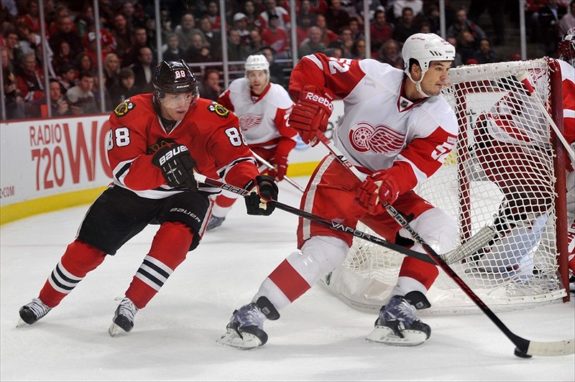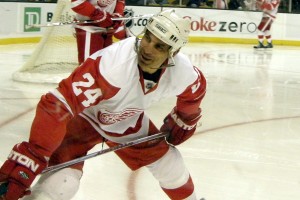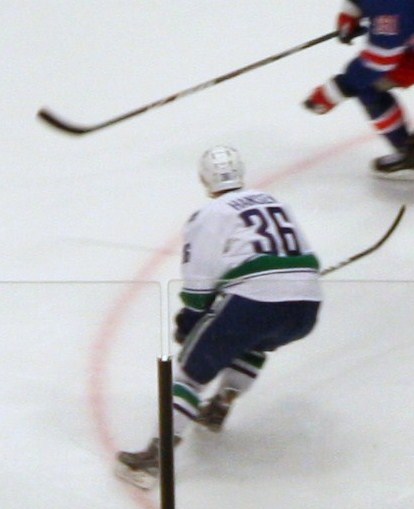
Chicago and Detroit. The classic rivalry between two Original Six teams that emulates more of a “big brother” rivalry than a pure hatred between two foes. Any Blackhawks fan worth their breath will tell you that “Detroit Sucks,” but deep down they all know that there is a mutual respect between both teams on the ice. I do understand that it is difficult to admit to one another due to the deep seeded battles throughout their 87 year histories, but that respect is certainly there and the blood shed from any game is far from toxic.

In recent history, most of the angst came after Chris Chelios, a Chicago native, bolted across the pond in order to join the Red Wings, ultimately spawning a decade of mediocrity. Through years of dwelling in the basement of the league, the Blackhawk’s saving grace was pretty much any game against the Detroit Red Wings. Yes, admittedly, the only benchmark of each pathetic season was mustering a couple wins against the big brother each year.
Years later, the Blackhawks began their rise to relevancy again; hosting the Red Wings in the Winter Classic and eventually returning to the playoffs in 2009, although it was only fitting that they were ousted by Detroit. If the veteran Red Wings learned anything about that series, its that the young Blackhawks were well on their way to supplanting them for the top brother status, just not quite there yet.
This is only a small sample, a microcosm of the history shared between these two organizations. Chicago vs. Detroit could be one of the longest served rivalries in the NHL today, but in modern history it never compared to the hatred that Chicago fans felt for opponents such as the Minnesota North Stars through the 1980’s and early 1990’s, and in similar fashion Detroit would say the same about the Colorado Avalanche in the late 1990’s and early 2000’s. Since the North Stars went South (to Dallas), so did the rivalry. The Blackhawks and Stars organization never rekindled that hatred and eventually the rivalry fizzled out as fast as the team packed their bags. Similarly, the bad blood between Detroit and Colorado has seemed to clean itself in the past five years or so as the organization has filtered its player personnel.
Without the North Stars, the Blackhawks fans and players fed on the rivalry with Detroit throughout the basement years, it was all they had. But, with their rise in the standings, a new rival was born and had only begun to heat up in the spring of 2008-2009, the first year the Blackhawks made the playoffs since the 2001-2002 season and only the second time they made the post season in 11 years. That year they faced the Vancouver Canucks in the playoffs, which spun a hatred that Blackhawks fans hadn’t felt since the North Stars came into the Chicago Stadium with the likes of Dino Ciccarelli, Brian Bellows, Keith Acton, Basil McRae, Shane Churla, and Willi Plett always willing to get the fireworks going. This time, the same spark came across the Blackhawks eyes after Kevin Bieska, Alex “Hair Puller” Burrows, Shane O’ Brien, Willie Mitchell, Ryan Kesler, and the popular dubbed Sedin “sisters” came into the United Center in March of 2009, just before the playoffs began and a brawl ensued just after Dustin Byfuglien tagged Roberto Luongo.
This game was the spark that ignited a forest fire between both organizations. Truly, this is the bad blood that the Red Wings never spilled on the United Center ice, and the thirst of another hot rivalry had only begun to be quenched. Ryan Kesler and Daniel Sedin were labeled divers worthy of Oscar performances, Alex Burrows was mocked for his cowardly fistful of hair, and Bieksa was laughed at for his Alex Semin-esque slap fight with Ben Eager.
Later that same year, the two teams engaged in a heated playoff series that left no kind words between the two teams after Patrick Kane wiped the arrogance off the Canucks faces with a hat trick in game six and sent Vancouver to the golf course. Luongo and the Canucks became notorious for their playoff implosions after this series, showing that they can be knocked off their game with a little agitation. Dustin Byfuglien, Andrew Ladd, Kris Versteeg, and Dave Bolland became masterminds at getting under the skin of the Canucks, and not only the team on the ice, but the entire city of Vancouver hated them for their physical prowess. They had a lot of sandpaper, yet their demeanor on the ice was calm, cool, and collected… more recipe for frustration. At this point, Blackhawks fans had only found humor in facing the Canucks, knowing that they were full of headcases, divers, and hair-pulling lunatics.
However, the following year Willie Mitchell delivered a blindside hit to Jonathan Toews. No one was laughing. This time around, the revenge would only taste sweeter as the Blackhawks knocked the Canucks out of the Western Conference Semi-finals for the second straight year. Vancouver was perhaps even more arrogant this time around, crying foul and even proclaiming that they deserved to win the series, so it was only fitting for the Blackhawks to roll through the San Jose Sharks, Philadelphia Flyers, and eventually win the Stanley Cup that year.

After the Blackhawks purged the roster in order to stay within salary cap regulations, they fell to 8th in the conference. Meanwhile, Vancouver took the top honors as the 1st seed and were able to add two more hated additions in Raffi Torres and Maxim Lapierre that seemed to fit perfectly with the villains they had become. In the playoffs both teams met in the Western Conference Quarter-finals and the Blackhawks were knocked out in seven games. A lot of controversy stirred around that series, although there is never a lack of drama whenever the Blackhawks and Canucks meet up. During the series, Raffi Torres took out Brent Seabrook with a clear cut shot to the head (by the way, no suspension on this play) and Mike Gillis further cemented the “Crying Canuck” moniker after complaining to the media about officiating before game seven of the series. Huh? Of course, this was all broadcasted at a national level as the Canucks went on to lose to the Boston Bruins in the Stanley Cup Finals and really cemented their status across the NHL as the most hated team in hockey for their antics. In a way, it was almost worth it for Blackhawks to lose to the Canucks in the playoffs, only to see Vancouver fail on such a big stage while the Blackhawks were only one year removed from winning the Stanley Cup.
After three straight years of playoff battles, the 2011-2012 season saw much of the same attitude between both teams, especially with the new additions of Dan Carcillo in Chicago and Zack Kassian in Vancouver. Both teams didn’t face each other in the playoffs, but the rivalry continued to get hotter after Duncan Keith threw a retaliatory elbow on Daniel Sedin which netted him a five game suspension, and rightfully so, prompting Keith to apologize for the hit. The response was in retaliation towards a late hit to the head earlier in the game, although still inexcusable.

This season the two teams faced off in Chicago was just more fodder for Blackhawks fans to have against the Vancouver Canucks. The Canucks may have scored the first goal to kick off the game, but leading up to the third period the Blackhawks were rolling with momentum. Marian Hossa, in particular, was having a fantastic game up to that point, scoring two goals to give the Blackhawks a 3-1 lead and he was sniffing for the hat trick. The entire building was buzzing, just waiting for Hossa to touch the puck in anticipation for a shot on goal.
Suddenly, dead silence swept the building the moment that Marian laid motionless on the ice: Jannik Hansen took him out, thrusting his elbow into the back of Hossa’s head, which Jansen claimed was an attempt at the puck. Hansen received a suspension for one game, which was clearly scoffed at by the Vancouver Canucks organization. But this is something we have all come to expect from an organization that demands respect, but fails to give any out. Earlier in the year, Hansen proceeded to build on the Canucks awful reputation throughout the league after cross-checking a referee from behind, along with many more incidents that have never resulted in suspensions or fines.
I can only imagine if the shoe were on the other foot here how GM Mike Gillis and head coach Alain Vigneault would react, past history indicates that they wouldn’t be chuckling. It all starts from the top, and it’s clear that the two-headed dragon of Gillis and Vigneault continues to breed and preach a dishonorable game through their actions. It all trickles down to the ice, cultivating a sense of entitlement in the city, and fooling the media and fans into believing that they are the ones getting duped by the NHL at every cost. This duo loves shifting the blame, absolving themselves of all responsibility, and waving the white flag at signs of adversity because after all, that is the culture that Vancouver has based itself off of. It will be a better day for Vancouver the sooner the these two are waiting in the unemployment line, where they can truly flaunt their “woe is me” attitudes.
This rivalry has spilled over the boards and into the stands. So while the rivalry between Chicago and Detroit may be the longest served, in the short term the bad blood between Chicago and Vancouver is stronger with hatred, on and off the ice. It’s so strong that I’ve actually seen scenarios where Chicago fans and Detroit fans have actually rooted for each other if they are playing against the Canucks, such as the recent 8-3 blowout.
There are other rivalries that are worth noting, such as the recent addition Phoenix Coyotes thanks to Mike Smith’s oscar performance and Raffi Torres trying to end another career. St. Louis ranks somewhere on that list, as we all know how dirty they can be (with pride), but until the two teams meet in the playoffs it’s nearly impossible to develop a hatred towards them on the same level of the Vancouver Canucks or even the Phoenix Coyotes.
Like the way of the Minnesota North Stars, some day the rivalry with the Vancouver Canucks will die down, as all good things come to an end. Players move on, organizations change directions, and eventually the flame dies down. So enjoy the fire while it lasts, if this season is any indication to the future of this rivalry, it’s that there’s plenty of wood left to burn.
If you have any other rivalry moments, hated teams, or hated players, sound off below!